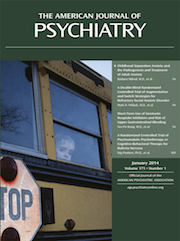Adequate Dosing for Second-Generation Antipsychotics in Establishing Treatment Resistance in Schizophrenia
To the Editor: Treatment resistance in schizophrenia requires evidence of two previous failed antipsychotic trials of 6 weeks at a dose of 600 mg in chlorpromazine equivalents (1), while the original criteria for clozapine’s role in treatment resistance stipulated a dose of 1,000 mg in chlorpromazine equivalents (2).
Second-generation antipsychotics have largely supplanted their first-generation counterparts in the last decade, and studies have attempted to derive chlorpromazine equivalents for these agents either through expert consensus or calculation methods. This calls into question the impact of these different approaches on studies employing chlorpromazine equivalents.
The estimated doses of five commonly prescribed second-generation antipsychotics, using four widely used methods, are listed in Table 1. Immediately apparent is the wide variation in calculated doses for any given second-generation antipsychotics; for example, at 600 mg of chlorpromazine equivalents, doses of risperidone vary between 6 mg and 12 mg and doses of aripiprazole vary between 24 mg and 45 mg. These differences are amplified at 1,000 mg of chlorpromazine equivalents.
| 600 mg Chlorpromazine Equivalents | 1,000 mg Chlorpromazine Equivalents | Dosing | |||||||||
|---|---|---|---|---|---|---|---|---|---|---|---|
| Drug (mg) | Consensus | Calculation | Consensus | Calculation | Highest Dose | Recommended Rangea | |||||
| Kaneb | Gardnerc | Woodsd | Andreasene | Kaneb | Gardnerc | Woodsd | Andreasene | Kaneb | Gardnerf | ||
| Risperidone | 6.6 | 6 | 12 | 7.9 | 11.7 | 10.0 | 20.0 | 13.2 | 10.5 | 8.5 (1.0) | 2–8 |
| Olanzapine | 24.0 | 20 | 30 | 28.5 | 33.3 | 33.3 | 50.1 | 47.5 | 40.0 | 30 (0) | 10–20 |
| Quetiapine | 720.0 | 750 | 450 | 852.0 | 1,000.0 | 1,250.0 | 751.5 | 1,420.0 | 950.0 | 1,000 (162) | 300–750 |
| Ziprasidone | 168.0 | 160 | 360 | 303.0 | 200.0 | 266.7 | 601.2 | 505.0 | 180.0 | 200 (40) | 80–160 |
| Aripiprazole | 24.0 | 30 | 45 | 38.5 | 33.3 | 50.0 | 75.2 | 64.2 | 30.0 | 30 (0) | 10–30 |
| Haloperidol | 12.0 | 10 | 12 | 11.0 | 22.2 | 16.7 | 20.0 | 18.4 | 25.0 | 20 (4.0) | 6–20 |
At 1,000 mg of chlorpromazine equivalents, calculated doses for the second-generation antipsychotics uniformly exceed the maximum dosages currently recommended for these agents (3). Even at 600 mg of chlorpromazine equivalents, values frequently lie outside the recommended dosage range. As importantly, the calculated doses differ markedly based on the method employed.
This variance raises practical considerations, for example, in declaring a failed second-generation antipsychotics trial in the process of defining treatment-resistant schizophrenia. The wide variation challenges the validity of using chlorpromazine equivalents to compare across antipsychotics. The reported near-maximal effective dose of chlorpromazine was 400–450 mg, not 600–1,000 mg, and there appears to be little evidence to support high doses in treatment-resistant schizophrenia (4). In addition, the high doses calculated raise serious safety concerns and fly in the face of regulatory dosing recommendations. Accordingly, adopting chlorpromazine equivalents may not be appropriate for evaluating an adequate dosage for specific second-generation antipsychotics, and we suggest that a more appropriate means to confirm a failed clinical trial is suboptimal response at the maximum recommended dosage range for a specific second-generation antipsychotics, as per product monograph.
1 : Management of treatment resistance in schizophrenia. Biol Psychiatry 2001; 50:898–911Crossref, Medline, Google Scholar
2 : Clozapine for the treatment-resistant schizophrenic: a double-blind comparison with chlorpromazine. Arch Gen Psychiatry 1988; 45:789–796Crossref, Medline, Google Scholar
3 ;
4 ;
5 : International consensus study of antipsychotic dosing. Am J Psychiatry 2010; 167:686–693Link, Google Scholar
6 : Chlorpromazine equivalent doses for the newer atypical antipsychotics. J Clin Psychiatry 2003; 64:663–667Crossref, Medline, Google Scholar
7 : Antipsychotic dose equivalents and dose-years: a standardized method for comparing exposure to different drugs. Biol Psychiatry 2010; 67:255–262Crossref, Medline, Google Scholar
8 : Dose response and dose equivalence of antipsychotics. J Clin Psychopharmacol 2004; 24:192–208Crossref, Medline, Google Scholar



